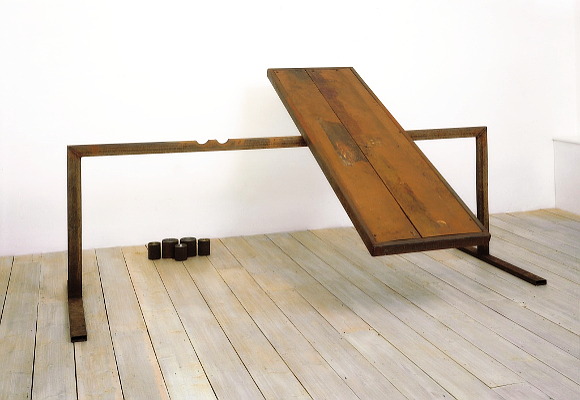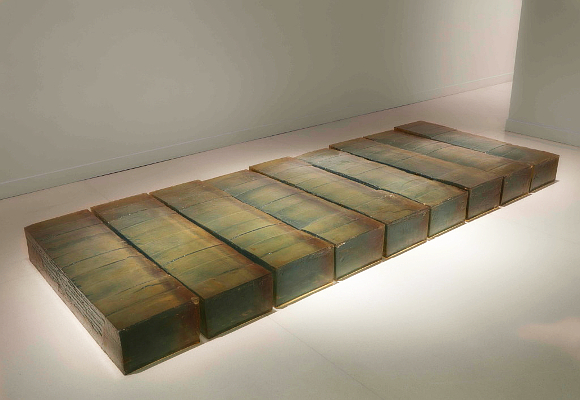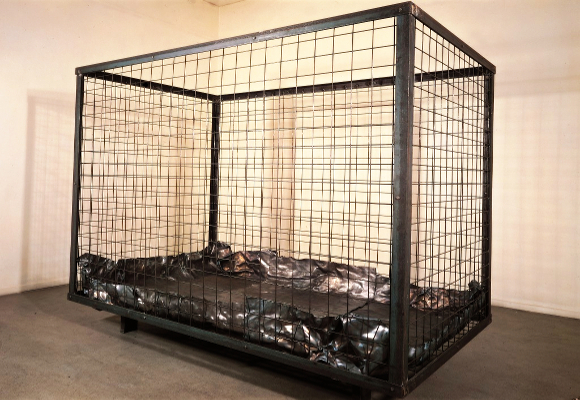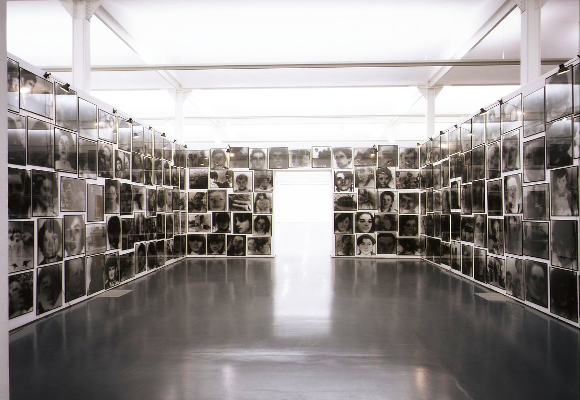Three Narratives. Participation. Memory.
The so-called “new” art media are used, but “traditional” techniques like painting and drawing also survive.

Can we explain and classify contemporary art through a single chronological narrative, as has been done with all previous art? Would it not it be more appropriate to propose a simultaneity of discoursesthat allow us to approach creativity today from different points of view? This is the idea that underlies Three Narratives, the new cycle of exhibitions presented by ”la Caixa” Foundation at CaixaForum Barcelona, based on the organisation’s Collection of Contemporary Art.
The Foundation invited the poet, essayist, critic and museum director Enrique Juncosa to delve into the ”la Caixa” Collection and suggest new interpretations of the works conserved in it. Accordingly, Juncosa took inspiration from certain narrative structures found in the world of literature and film today to present a cycle of three exhibitions based on three concepts found frequently in works by contemporary artists.

Following the first exhibition, Participation, Juncosa now presents Memory. This second show in the series features a series of paradigmatic works from the collection in which the concept of memory provides the starting-point for meditation on the individual conscience. The exhibition generates a dialogue between the outstanding work by Joseph Beuys that occupies a permanent space at CaixaForum Barcelona and pieces by Miroslaw Balka, Rachel Whiteread, Susana Solano, Carmen Calvo, Christian Boltanski, Robert Gober, Guillermo Kuitca, Juan Muñoz and Doris Salcedo
There exists a general consensus as to how twentieth-century modern art should be organised, but only up to the nineteen-sixties. From that point until the present, contemporary art turns into something that is impossible to reduce to a single narrative capable of explaining the whole phenomenon. Many different aesthetic movements are found side-by-side. The so-called “new” art media are used, but “traditional” techniques like painting and drawing also survive. Certain art forms emerge and become firmly established that even deny the validity of the art object, whilst others are hybrids of categories that were formerly fixed and clear. We find artists all around the world, from Argentina to Thailand via Berlin, Iran and India, who contribute their own cultural and contextual perspectives to the global discourse.
Based on this theoretical framework, the cycle takes the shape of three successive exhibitions whose main goal is to show how participation, memory and language have operated as creative and speculative strategies in artistic creation over the past three decades. To this end, the pieces selected are presented in reverse chronological order, and vanishing points, intersections and meeting places are sought in order to extract new narratives from the works that form the ”la Caixa” Collection of Contemporary Art. Accordingly, the works included in the first sample, Participation, included pieces added more or less recently to the collection. They explore practices predominant since the late-nineties and that, in most cases, go beyond the art object. Generally speaking, we find that their significance resides outside the works themselves, which require participation on the part of the spectator.

The works included in the second show, entitled Memory, many of which date back to the early-nineties, are more important as triggers for interpretations based on the memory, both that of the artist and that of the viewer, than as art objects, although their materiality is still important. Most focus on such themes as disease, social or political violence, as well as different issues concerning identity. In the third and last show in the cycle, Language, the meaning of the work resides in the pieces themselves. These are works that were created, for the most part, in the nineteen-eighties, or, if later, follow criteria explored at the start of that decade.
Repositories of memory , The exhibition takes memory as the starting point of individual consciousness: the idea is to search within oneself and find a way to communicate the incommunicable. From the work of Christian Boltanski, Miroslaw Balka, Guillermo Kuitca and others, marked by the experience of the Holocaust, to the subject of the silence of in pieces by Carmen Calvo, the uncertainty of the human condition in the sculpture of Juan Muñoz, disease in a disturbing installation by Robert Gober, menace in the work of Susana Solano, violence in that of Doris Salcedo, and the dark background that lurks behind things in Rachel Whiteread’s installation for the 1997 Venice Biennale.

Amongst the most outstanding attractions in Memory is the installation by Joseph Beuys, Hinter dem Knochen wird gezählt – Schmerzraum (1983), one of the most important works in the ”la Caixa” Collection, which occupies a permanent exhibition space at CaixaForum Barcelona. Juncosa generates a dialogue between Schmerzraum and artists and works intimately related to and influenced by this piece.
The work of all the artists selected form responses to the different crises that we all face in the course of our lives, whether personal, social or historic. In doing so, their creations become repositories of memory, often painful, of those crises or rites of passage, and are able, in turn, to awaken the spectator’s own consciousness of his or her own equivalent experiences. This is a highly heterogeneous group of artists, although sculptors predominate amongst them. They are also multinational, this time around including practitioners from Europe, the USA and Latin America.

None are formalists and, in some cases, when they use found objects, such as furniture or old photographs, they are selected, not for their artistic qualities but for their precise ability to suggest certain questions. This is clear in the work of such artists as Calvo, Gober, Kuitca and Muñoz, interested in psychoanalysis and internal conflicts. Balka and Salcedo, moreover, use found or apparently time-worn objects to bring out their evocative power, suited to exploring the great historic traumas.
Whiteread does not work with found objects, but many of her sculptures are based on them, as well as on real spaces, and she also presents three-dimensional negative images, for example of fragments from public and private buildings. By doing so, she speaks of memory in a way that we might call literal, as well as poetic. Finally, the sculptures of Susana Solano, allude to both architecture and landscape, but based on the memory or experience of them, and not as if they were objective or independent concepts.

Steel, wood, linoleum and tin cans The Holocaust is one of the basic themes in the work of the Polish artist Miroslaw Balka (Warsaw, 1958), who explores the transitory nature of our lives and the conflict and suffering that assail us. Balka’s work also has a powerful autobiographical element, for he grew up in a family of funeral sculptors who lived in a neighbourhood full of houses abandoned by Jews who had disappeared during World War Two, in which one-third of the Polish Jewish community lost their lives.
Concerned by the historic memory of those terrible events, Balka uses found objects alongside others made from materials like wood, ash, iron, soap, linoleum, felt, cement and, more recently, video, all gray or brown in colour, resulting in a patina that suggests a worn appearance. Even in cases where his sculptures represent nothing that we recognise, its scale is always designed in relation to the human body and they are imbued with a clear symbolic intention which suggests that they have specific functions.

